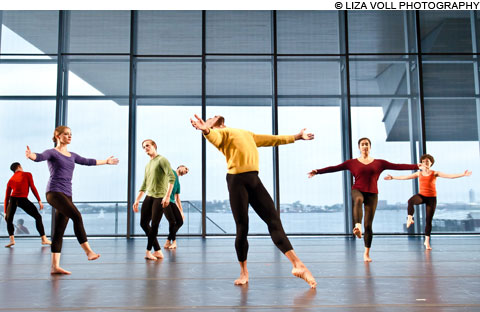
ELYSIAN FIELD The ICA Theater — with its uncurtained windows both reflecting the dancers and revealing the Boston waterfront — proved a sympathetic setting for Merce Cunningham's How To Pass, Kick, Fall, and Run. |
When Merce Cunningham started his dance company in 1953, he was a major new force in American Art. Witty, buoyant, mysterious, "abstract," and profoundly spiritual, his dances were mesmerizing and kaleidoscopic — no stories, and independent of their accompanying music. He created a company of American angels pretending to be modern dancers. Cunningham died in 2009; his company has disbanded; but the Cunningham Trust is taking excellent care of his legacy.
At the ICA, Summer Stages Dance at Concord Academy, founded and directed by Amy Spencer and Richard Colton, celebrated its 15th anniversary and the 100th birthday of composer and theoretician John Cage, Cunningham's life partner, with one of Cunningham's most joyous works, How To Pass, Kick, Fall, and Run, staged by Cunningham dancer Rashaun Mitchell (who started dancing as a student at Concord Academy), with nine dazzling young dancers, most still in school (one now with the Boston Ballet). Raymond Pinto (from Juilliard) was outstanding as the central guiding spirit Cunningham created for himself. Tall and lean, Pinto can move in more directions than you can count and all at once. These angels were star athletes — individuals, couples, and interweaving teams, making darting tandem leaps and sudden breathtaking switchbacks — playing and competing on the Elysian Field of the ICA Theater, with its uncurtained windows both reflecting the dancers and revealing the nighttime glamour of the Boston waterfront.
The "music" could have been Mozart, but is actually a recitation of delicious vignettes from Cage's prose. As part of Cage's exploration of chance, each performance should use a different selection. The reciters at the 1965 premiere were Cage himself and Cunningham archivist, historian, dancer, and choreographer David Vaughan, who, at 88, moderated the post-performance discussion with the creative team. The reciters here were poet Robert Pinsky and actor Oliver Platt, sitting at a desk, delivering their one-minute "stories" at one-minute intervals, the longer texts very fast, the shorter ones very slow, and sometimes simultaneously. They captured Cage's playfulness, and their buoyancy (Pinsky drinking Champagne, Platt with a can of Moxie) buoyed the dancers. Here's one of my favorite passages:
I went to hear Krishnamurti speak. He was lecturing on how to hear a lecture. He said, "You must pay full attention to what is being said, and you can't do that if you take notes." The lady on my right was taking notes. The man on her right nudged her and said, "Don't you hear what he's saying? You're not supposed to take notes." She then read what she had written and said, "That's right. I have it written down right here in my notes."
The evening began with Mitchell's 42-minute "work in progress," Interface, with a "live" electronic score by Thomas Arsenault (a/k/a Mas Ysa). The "visual design," by Fraser Taylor and Nicholas O'Brien, begins with projections of halves of the dancers' faces combined to make new faces with unsettlingly ambiguous expressions (half-smile/half-frown). In dim light we see two couples (two men, two women) who seem to be kissing, but as they begin to move around, their faces are — and remain — stuck together. In Cunningham, facial expression is irrelevant to the dancing (everyone looks benign), but Mitchell's dance is about facial expression. In one long sequence, the dancers manipulate each other's faces — their expressions are now, as one dancer put it afterwards, part of the choreography.